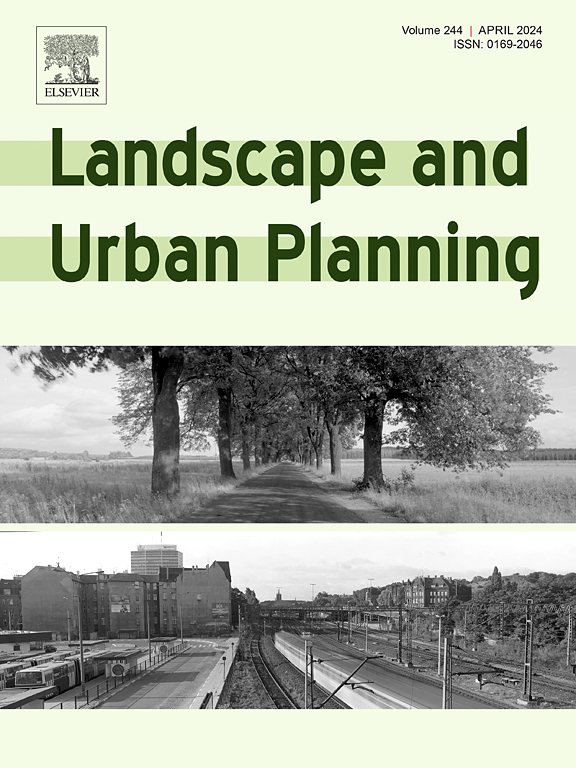衡量街道更新设计的有效性:来自视觉偏好调查、深度学习技术和眼动追踪模拟软件的见解
IF 7.9
1区 环境科学与生态学
Q1 ECOLOGY
引用次数: 0
摘要
本研究通过对心理和视觉感知的评估,探讨了城市更新项目(URPs)对街道空间视觉质量(VQoS)的影响,解决了经验证据的重大空白。本文分析了亚洲人口密集城市的51个urp,评估了绿地、步行性和开放性等空间特征的可测量变化如何影响更新前后感知的VQoS,以确定有效的街道改善措施。该方法包括捕获选定urp的多年谷歌街景图像(SVIs),并进行在线视觉偏好调查,以收集感知VQoS的数据。深度学习算法用于识别街景中的关键元素。此外,眼动追踪仿真技术被用于研究个体如何下意识地与视觉刺激相互作用,旨在确定感知到的VQoS的变化是否与转换后的街道元素捕获视觉注意力的容易程度有关。结果表明,VQoS的改善主要与绿化的增加有关,这表明增强的绿色空间有助于提高视觉吸引力。还有一种无意识的偏好,即在视觉上与街道元素相结合,例如建筑物和绿色植物,而不太详细的区域,包括人行道、车道和未经装饰的建筑立面,往往被忽视。此外,引人注目的新建筑立面设计可以显著提高VQoS。这些发现表明,城市设计干预措施应优先考虑将绿化和视觉刺激元素结合起来,以创造更具吸引力和视觉吸引力的街道空间,从而改善城市环境的整体视觉质量。本文章由计算机程序翻译,如有差异,请以英文原文为准。
Measuring the effectiveness of street renewal design: Insights from visual preference surveys, deep-learning technology, and eye-tracking simulation software
This study investigates the impact of urban renewal projects (URPs) on the visual quality of street space (VQoS) through the evaluation of both psychological and visual perception, addressing the significant gap in empirical evidence. Analysing fifty-one URPs in densely populated Asian cities with complex urban settings, it assesses how measurable changes in spatial features such as greenness, walkability, and openness affect perceived VQoS pre- and post-renewal to identify the effective street improvements. The methodology includes capturing multi-year Google Street View images (SVIs) of selected URPs and conducting online visual preference surveys to gather data on perceived VQoS. Deep learning algorithms were used to identify key elements within the street scene. Additionally, eye-tracking emulation technology was utilized to investigate how individuals subconsciously interact with visual stimuli, aiming to determine whether variations in perceived VQoS are linked to how readily transformed street elements capture visual attention. Results indicate that VQoS improvements are predominantly associated with increased greenery, suggesting that enhanced green spaces contribute to higher visual appeal. There is also an unconscious preference for visually engaging with street elements, such as buildings and greenery, while less detailed areas, including sidewalks, driveways, and unadorned building façades, are often overlooked. Moreover, attention-catching designs of new building facades can significantly enhance VQoS. These findings suggest that urban design interventions should prioritize incorporating greenery and visually stimulating elements to create more engaging and visually appealing street spaces, thereby improving the overall visual quality of urban environments.
求助全文
通过发布文献求助,成功后即可免费获取论文全文。
去求助
来源期刊

Landscape and Urban Planning
环境科学-生态学
CiteScore
15.20
自引率
6.60%
发文量
232
审稿时长
6 months
期刊介绍:
Landscape and Urban Planning is an international journal that aims to enhance our understanding of landscapes and promote sustainable solutions for landscape change. The journal focuses on landscapes as complex social-ecological systems that encompass various spatial and temporal dimensions. These landscapes possess aesthetic, natural, and cultural qualities that are valued by individuals in different ways, leading to actions that alter the landscape. With increasing urbanization and the need for ecological and cultural sensitivity at various scales, a multidisciplinary approach is necessary to comprehend and align social and ecological values for landscape sustainability. The journal believes that combining landscape science with planning and design can yield positive outcomes for both people and nature.
 求助内容:
求助内容: 应助结果提醒方式:
应助结果提醒方式:


